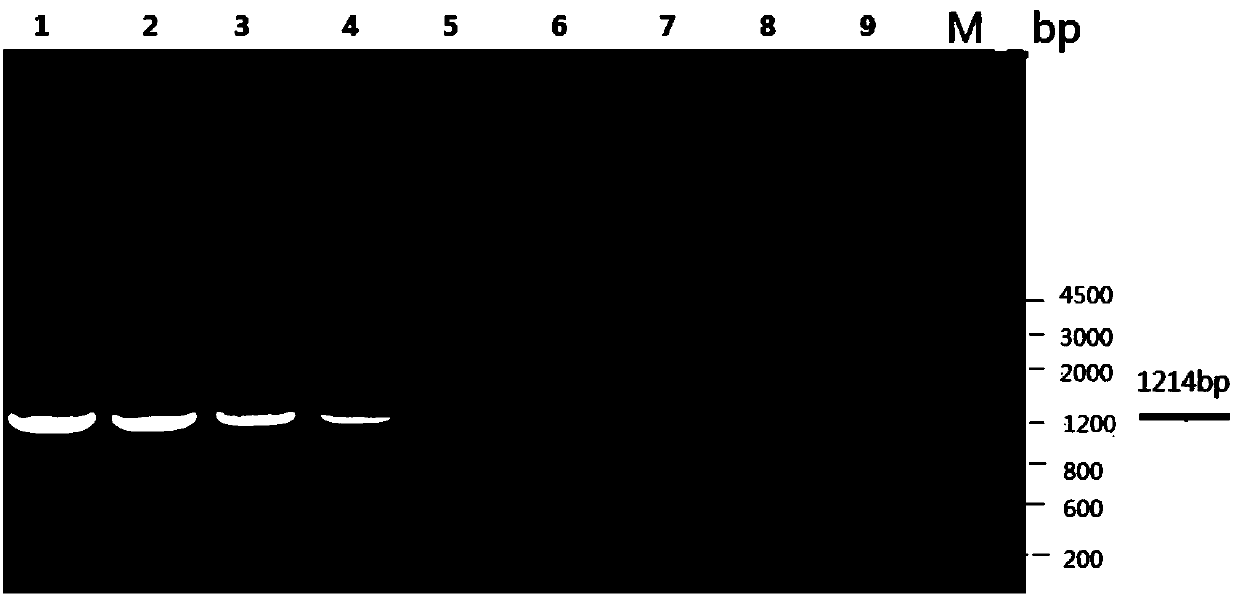K subgroup avian leukosis virus detection kit
An avian leukemia virus and kit technology, applied in the field of molecular biology, can solve the problems of difficult screening, affecting primer specificity, small space, etc., to reduce costs and complicated operations, strong specificity and sensitivity, and shorten the detection period. Effect
- Summary
- Abstract
- Description
- Claims
- Application Information
AI Technical Summary
Problems solved by technology
Method used
Image
Examples
Embodiment 1
[0036] 1. Design of fluorescent quantitative PCR primers
[0037] According to the host range of avian leukosis virus (ALV), the interference characteristics of the virus envelope, the type of cross-neutralization reaction and the molecular characteristics of the genome, the avian leukemia virus (ALV) can be divided into 11 subgroups from A to K, of which chicken-derived ALV There are 7 subgroups A, B, C, D, E, J and the new K subgroup, and the nucleotide sequences of other subgroups have different degrees of homology with the ALV-K nucleotide sequence, among which The nucleotide sequence homology between endogenous avian leukosis virus (ALV-E) and ALV-K is the highest (93.7%-97.5%), and there are only two parts of nucleotide sequences with large differences in the gp85 region (region 1: 5836-5925 is 77bp in length, region 2: 6039-6116bp is 89bp in length). In order to exclude the interference of ALV-E and other subgroups, referring to the sequences of multiple strains of ALV...
Embodiment 2
[0054] Example 2 Conventional PCR Sensitivity Experiment
[0055] The positive plasmid obtained in Example 1 was treated with dd H 2 O was serially diluted 10-fold, wherein lanes 1-8 were 10 8 、10 7 、10 6 、10 5 、10 4 、10 3 、10 2 、10 1 copy / μL, lane 9 is a negative control, amplified according to the system and procedure described in Example 1, the results are as follows figure 2 As shown, the band size is 84bp;
[0056] The routine PCR positive plasmid was used ddH 2 O sequentially carry out 10-fold serial dilution, wherein 1-8 is 10 8 、10 7 、10 6 、10 5 、10 4 、10 3 、10 2 、10 1 copies / μL, 9 is the negative control, amplified according to the conventional PCR system and procedures, the results are as follows image 3 As shown, the band size is 1214bp; according to figure 2 The results show that the conventional PCR reaction with fluorescent quantitative PCR primers can detect a minimum of 10 4 copies / μL.
[0057] according to image 3 As a result, it can ...
Embodiment 3
[0058] Embodiment 3 fluorescence quantitative PCR sensitivity experiment
[0059] The positive plasmid that embodiment 1 makes is used ddH 2 O sequentially carry out 10-fold serial dilution, wherein 1-8 is 10 8 、10 7 、10 6 、10 5 、10 4 、10 3 、10 2 、10 1 copies / μL, the diluted positive plasmid standard was subjected to fluorescent quantitative PCR reaction, the 20 μL reaction system was 0.5 μL of 10 μM upstream primer, 0.5 μL of 10 μM downstream primer, 10 μL of 2×iTaq UniversalSYBR Green Supermix, 1 μL of cDNA template , RNase free H 2 O 8 μL. The reaction program was: pre-denaturation at 95°C for 3 min; 40 cycles of 95°C for 15 s and 60°C for 34 s, collecting fluorescence at 60°C for each cycle; 95°C for 15 s, 60°C for 1 min, and 95°C for 15 s. And make a kinetic curve, the result is as Figure 4 shown.
[0060] according to Figure 4 The results show that the sensitivity detection of fluorescent quantitative PCR can detect as low as 10 1 copies / μL of positive pl...
PUM
| Property | Measurement | Unit |
|---|---|---|
| Sensitivity | aaaaa | aaaaa |
| PCR efficiency | aaaaa | aaaaa |
Abstract
Description
Claims
Application Information
 Login to View More
Login to View More - Generate Ideas
- Intellectual Property
- Life Sciences
- Materials
- Tech Scout
- Unparalleled Data Quality
- Higher Quality Content
- 60% Fewer Hallucinations
Browse by: Latest US Patents, China's latest patents, Technical Efficacy Thesaurus, Application Domain, Technology Topic, Popular Technical Reports.
© 2025 PatSnap. All rights reserved.Legal|Privacy policy|Modern Slavery Act Transparency Statement|Sitemap|About US| Contact US: help@patsnap.com



